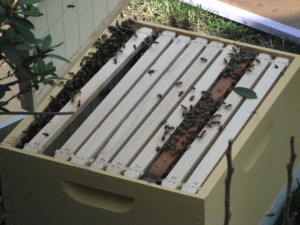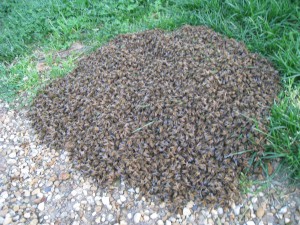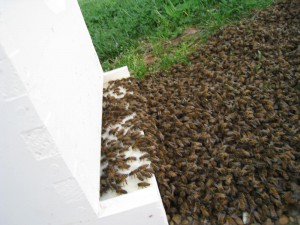A Swarm Here, A Swarm There, A Swarm Everywhere!

Things have definitely kicked into 3rd gear in Richmond, Virginia. I had offered to show Greg, a fellow that lives to the south of me across the James River, some of my hives to demonstrate to him that beekeeping was not as dangerous as some might think. On my way to meet Greg, I get a call from a nice lady in the West End – ‘There are a nest of honey bees in a bush in my front yard. Can you do something about them?’ Of course I could! This was great news (although you can’t be sure on swarm calls if you really have honey bees, her husband seemed to be sure that they were honey bees, so I was excited.) I took her name and address and advised I would touch base in about an hour. Removing swarms of honey bees in Richmond, Virginia gives me more pleasure then just about anything!
I hooked up with Greg and began to give him a tour of my home apiary (or Nuc yard.) As we moved into the yard (which is all Nuc’s with one larger hive (Larry) that I stole a queen from a few weeks ago), I answered some of his questions about bees and beekeeping. In the process, ‘swarms‘ came up and I explained why they happened and mentioned, off hand, that I had never seen one in my backyard. Greg then said, ‘do you mean something like that?’ as he pointed to a huge pile of bees in a nearby cryptomeria! ‘Yes! Exactly like that’, I exclaimed as I ran to get a box and hived the first swarm of the day and season (for me). I think this swarm had to come from Larry, which is a lesson for me. I took the old queen from Larry two weeks ago, along with a couple of other frames with queen cells on them. I even shook some nurse bees out of that daggone hive. Since then, a queen (or more then one) should have emerged, gotten her legs under her and even made a mating flight or three. I honestly cannot figure out they could have swarmed today. If they had swarmed a week ago, I would have figured that they swarmed with a virgin. But today? Weird. Unfortunately, I did not have time to check them, so I may never really know.
The Nuc’s were all doing well, although I did discover that Nuc D was trying to swarm. It was really a learning lesson for me, as I shook too many nurse bees in with that queen (from the Westover hive). I had actually taken a frame of brood and bees from them to bolster Nuc E a week ago, but it apparently didn’t make a difference. I took the old queen and dropped her in a new Nuc and left Nuc D to make another new queen on their own (this really made them mad, by the way…) This time, I made sure to put a bit less brood and nurse bees with her, to reduce the crowding.

Finally, I packed up my gear and headed out to get the West End swarm. This was definitely going to be new genetics for my yards and I was excited about getting (yet another) swarm. My experiences with swarms last year have taught me that no bee builds up like a bee from a swarm. When we arrived, I immediately noticed the bees in an azalea bush. A tremendous-sized swarm, to be sure. It had to be the size of a couple of footballs! The location was a bit tricky, but Linda and Gary (the nice folks who called about the swarm) said that I could cut the branches if I wanted. Fortunately, I was able to shake the swarm into the hive and pull it out safely. I did end up cutting one branch, only because the bees kept trying to congregate on the branch (even though I could see the bees fanning at my box and steadily entering the hive – which meant to me that the queen was onboard!)
Normally, I would have left the box there and come back after dark to get all of the bees (when all of the bees, including the scouts, should have returned to my new box with the queen). But, this was a 40 minute drive from my house, so we were talking about a lot of driving. In the end, I let them collect bees for another 20 minutes or so and then taped them up, returning them to my yard. I immediately put feed on them (and my other swarm), as my swarms of 2010 all greedily took up sugar water while they built out 2 deeps of frames. This is one of the few times that I really think it is important to feed your bees. Swarms are wax building machines. Feed those machines to keep them running and they will draw out comb like no one’s business.
Although this was a banner day for swarms (and two new Nucs), I must say that there are a couple of hives in Charles City that I have to wonder about. Have they swarmed? Who knows. I will know more this weekend.


